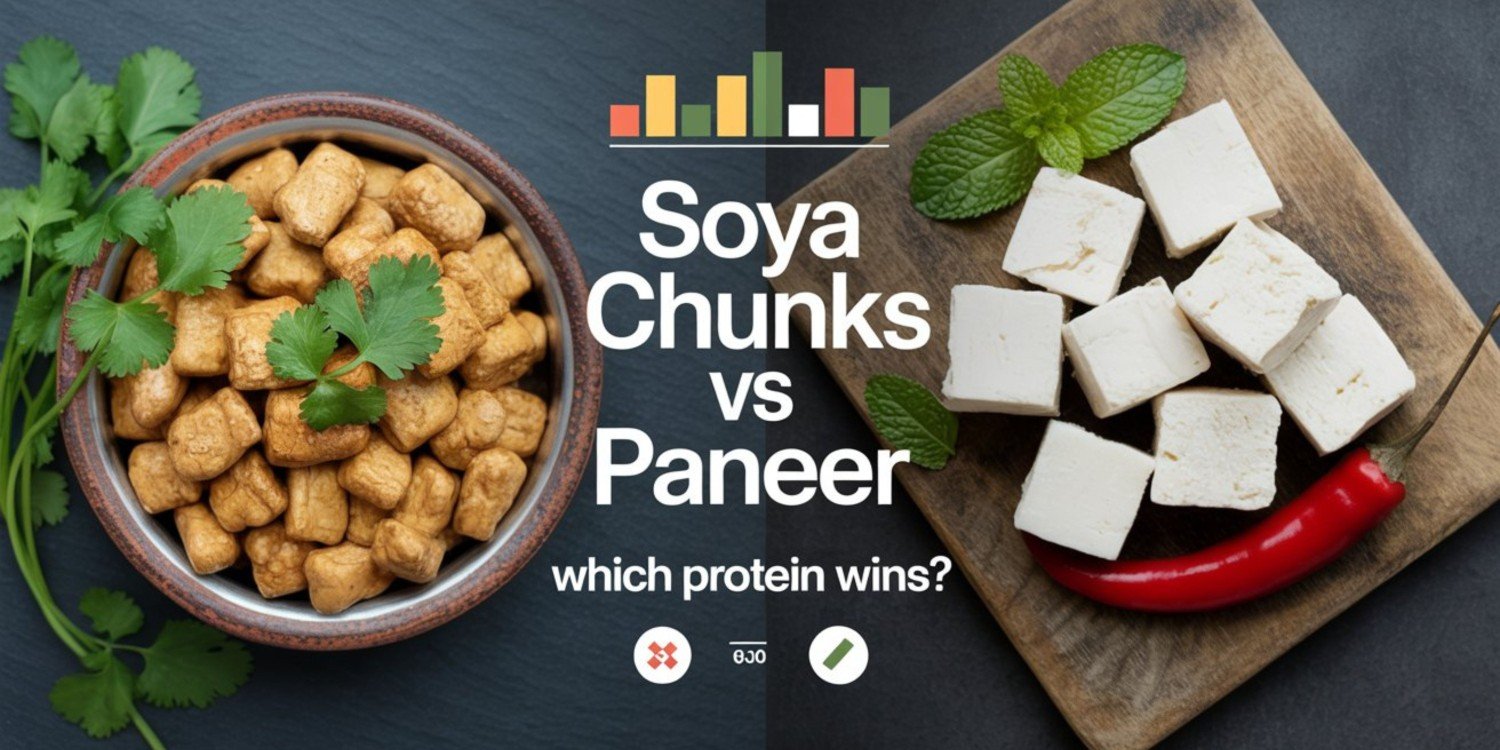

Dt. Natasha Mohan
Dietitian Natasha Mohan is one of the most influential and renowned nutritionist and dietitian, with over 3 Million Followers on YouTube and 200+ Million Views and with 10+ Years of Experience. Dietitian Natasha Mohan is a transformation expert, Motivational Speaker and Lifestyle Expert. She has touched million of lives. She specializes in Therapeutic Diets Like, PCOS/PCOD, Thyroid, Diabetes, Cholesterol, Blood pressure, and other lifestyle disorder.
Table of Contents
Soya Chunks vs Paneer – Which Protein Is Better for You?
Soya Chunks vs Paneer is a common debate among health-conscious individuals, especially vegetarians looking to boost their protein intake. Both these protein-rich foods are popular in Indian kitchens and have their unique nutritional benefits. But when it comes to making the healthier choice, which one truly stands out? Let’s break down the nutritional content, benefits, and drawbacks of both to help you decide which protein is better suited for your diet.
1. Nutritional Comparison
Soya Chunks: The Plant-Based Powerhouse
Soya chunks are made from defatted soy flour and are known for their high protein content. A 100-gram serving of cooked soya chunks provides:
Protein: ~52 grams (dry weight)
Calories: ~345 kcal
Carbs: ~33 grams
Fat: ~0.5 grams
Fiber: High
Soya chunks are an excellent source of plant-based protein, making them ideal for vegans and vegetarians. They’re also cholesterol-free and rich in iron, magnesium, and calcium.
Paneer: The Dairy Delight
Paneer, or Indian cottage cheese, is derived from curdled milk. A 100-gram serving of paneer offers:
Protein: ~18 grams
Calories: ~265 kcal
Carbs: ~1.2 grams
Fat: ~20 grams
Calcium: High
Paneer is rich in casein protein, which digests slowly and helps in muscle retention. It’s a great choice for weight gainers and fitness enthusiasts looking for healthy fats and steady protein release.
2. Digestibility and Absorption
When comparing Soya Chunks vs Paneer, digestion is a key factor. Paneer is a dairy product and contains casein, a slow-digesting protein that keeps you full longer and is easy to absorb. On the other hand, soya contains phytoestrogens and anti-nutrients like phytates, which can interfere with mineral absorption if consumed in excess.
However, cooking and soaking soya chunks properly can reduce these anti-nutrients, making them easier to digest.
3. Muscle Building and Fitness Goals
If your goal is muscle gain, Soya Chunks vs Paneer becomes a performance-based comparison. Paneer is often favored in strength training diets due to its fat and casein content. It provides a steady stream of amino acids during sleep if consumed at night.
Soya chunks, on the other hand, are low in fat and high in protein, making them ideal for lean muscle building and fat loss. For vegans, soya chunks are a great alternative to whey or casein proteins.
4. Weight Loss and Satiety
When it comes to weight management, Soya Chunks vs Paneer takes an interesting turn. Soya chunks, being low in fat and high in fiber and protein, offer greater satiety with fewer calories. This makes them a preferred choice for people aiming to lose weight without compromising on protein intake.
Paneer, though nutritious, has a higher fat content, which may not be suitable for calorie-restricted diets unless portion-controlled.
5. Affordability and Availability
Soya chunks are cheaper and more accessible compared to paneer. A packet of soya chunks costs significantly less than fresh paneer, making them a budget-friendly protein option, especially for large families or daily consumption.
Paneer, while easily available, can be more expensive, especially if you prefer organic or homemade versions.
Final Thoughts
So, who wins the battle of Soya Chunks vs Paneer? The answer depends on your dietary preferences, fitness goals, and lifestyle. If you’re looking for low-fat, high-protein, and budget-friendly food, soya chunks are the way to go. But if you prefer healthy fats, slow-digesting protein, and a versatile dairy product, paneer may be your best bet.
For most people, including both in a balanced diet can offer the best of both worlds. Just ensure proper portion control and preparation techniques for optimal nutrition. Whether you’re planning your next protein-rich meal or something seasonal and comforting like an Aloo Methi Recipe, variety is key to enjoying a healthy diet.
Soya chunks offer higher protein content per 100 grams, making them excellent for muscle gain. However, paneer has casein protein and healthy fats that also support muscle recovery.
Yes, combining both in your meals can give you a balanced mix of plant and animal protein, improving your overall amino acid profile.
Moderate consumption is safe, but excessive intake may affect hormone levels due to phytoestrogens. Always cook and soak soya chunks properly before use.
Soya chunks are lower in fat and higher in fiber, making them a better choice for calorie-restricted diets and weight loss.
Paneer contains less lactose than milk, but those with severe intolerance may still face discomfort. Lactose-free alternatives are recommended.


